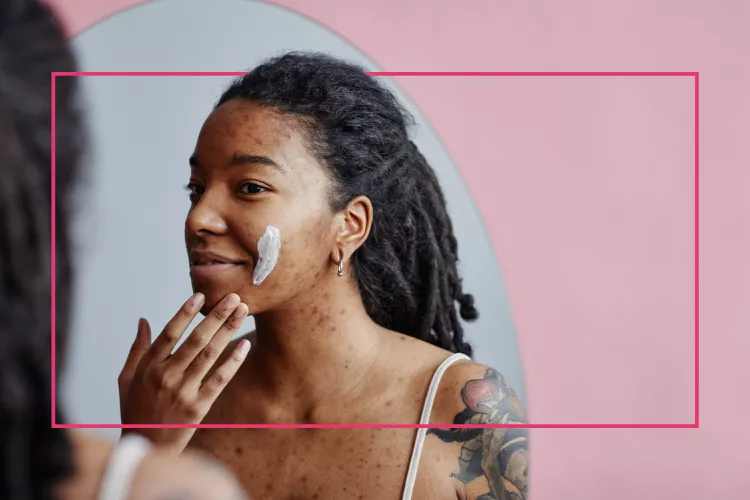Embark on a journey to unveil the secrets behind minimizing those stubborn scars.
Scars. They’re like little badges of past adventures or battles, narrating tales of childhood mishaps, surgeries, or those dreaded acne breakouts. While they are proof of our body’s incredible healing powers, the urge to lessen their prominence for a smoother, clearer skin is quite common.
Navigating the beauty market, you’ll find it brimming with scar creams, each vowing to gift you a flawless skin. But do these creams really hold the secret to fading scars, or is it just a marketing gimmick?
Join us as we team up with the renowned NYC-based Latina medical aesthetician, Evelyn Ramirez, the proud owner of Evelyn Aesthetics, to delve deeper into the fascinating world of scar creams. From understanding the genesis of scars to the nitty-gritty of scar creams and other expert advice on treatments, here’s your guide to bidding scars goodbye.
How Do Scars Tell Their Story?
Scars are not just physical marks, but stories etched on your skin, testifying to your body’s resilient healing process when faced with injuries, both intentional and unintentional. The fascinating bit? The way these scars shape up can vary greatly.
As Ramirez elucidates, “Scars like hypertrophic, keloid, and atrophic ones narrate different stories of wound healing, each distinguished by its appearance and the underlying biological processes.” Let’s get acquainted with these characters in our story:
- Hypertrophic scars: Imagine a mound that doesn’t wander off its territory. It’s thick and rigid, thanks to an overdrive of collagen during the healing phase.
- Keloid scars: These are the rebellious ones, not confining themselves to the initial wound area and potentially expanding indefinitely. These scars have a rounded, plump demeanor, sometimes accompanied by itchiness or pain.
- Atrophic scars: These are the gentle dips in our skin’s narrative, usually formed due to tissue loss from conditions like acne or chickenpox, giving the skin a pitted or sunken look.
The Secrets Behind Scar Creams’ Magic
Now, let’s talk about those famed scar creams. They aren’t mystical entities but concoctions filled with elements renowned for their healing prowess. Ramirez sheds light on the ingredients like silicone, vitamin E, hyaluronic acid, and onion extract that grace these creams.
These components not only hydrate the skin but also bolster its flexibility and foster collagen production. Silicone stands out in this crowd, forming a protective sheath on the scar, effectively retaining moisture and assisting the scar’s healing journey.
But remember, embarking on the healing journey at the earliest is pivotal. “Beginning your scar treatment promptly can be a game-changer, guiding the healing journey in a positive direction. Scar creams play a nurturing role here, offering moisture, protection, and facilitating proper collagen formation while alleviating itching and inflammation,” emphasizes Ramirez.
Digging into the Science: Do Scar Creams Really Work?
While several clinical studies endorse the efficacy of scar creams, Ramirez notes that “the outcomes can be quite subjective, influenced by the nature of the scar, age, and individual reactions.” Younger scars seem to respond more favorably, and personal attributes like skin type, age, and overall health could sway the results.
But consistency is your best ally here, advises Ramirez. Choosing between scar creams and professional treatments such as laser therapy hinges on various factors including the severity of the scar, budget constraints, and personal preferences.
“Laser therapy stimulates collagen production, offering a more targeted approach compared to non-invasive scar creams. Alternatively, corticosteroid injections work wonders in reducing scar size,” adds Ramirez.
Safeguarding Your Skin: Precautions and Potential Side Effects
Despite their promising results, scar creams do come with a caveat. “Potential skin irritation or allergic reactions are not uncommon. Hence, a patch test and adherence to instructions are vital,” warns Ramirez.
Refrain from applying creams on open wounds and consult a healthcare provider for any emerging concerns. When picking the ideal scar cream, assess the scar’s characteristics and your skin’s sensitivity level.
Patience and regular application are essential in observing noticeable improvements. “While expecting an overnight transformation is unrealistic, consistent use can significantly diminish the visibility of scars, enhancing the texture, color, and overall appearance over time,” encourages Ramirez.
Embarking on the journey towards immaculate skin involves arming yourself with a wealth of scientific knowledge and expert advice. Before initiating any scar treatment, consult a healthcare provider to set realistic expectations. Remember, though scars may evolve, the rich narratives they encapsulate remain eternal.








